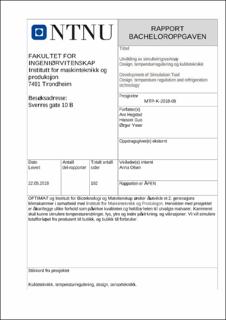| dc.contributor.advisor | Olsen, Anna | |
| dc.contributor.author | Hegstad, Are | |
| dc.contributor.author | Guo, Haowei | |
| dc.contributor.author | Yasar, Øzgur | |
| dc.date.accessioned | 2020-08-06T09:36:58Z | |
| dc.date.available | 2020-08-06T09:36:58Z | |
| dc.date.issued | 2018 | |
| dc.identifier.uri | https://hdl.handle.net/11250/2671056 | |
| dc.description.abstract | OPTIMAT og Institutt for Bioteknologi og Matvitenskap ønsker å utvikle et 2. generasjons klimakammer i samarbeid med Institutt for Maskinteknikk og Produksjon. Hensikten med prosjektet er å kartlegge ulike forhold som påvirker kvaliteten og holdbarheten til utvalgte matvarer. Kammeret skal kunne simulere temperaturendringer, lys, ytre og indre påvirkning, og vibrasjoner. Vi vil simulere totalforløpet fra produsent til butikk, og butikk til forbruker.
For å kunne designe og senere produsere klimakammeret, ble denne oppgaven presentert for studenter fra Konstruksjonsteknikk og Ventilasjon, Varme og Sanitærteknikk, med veiledning fra Institutt for maskinteknikk og produksjon.
Oppgaven ble valgt av seks studenter tverrfaglig bakgrunn, som delte seg i to grupper. Begge gruppene samlet seg i felleskap for å diskutere oppgaven og mulige problemstillinger.
Vår gruppe tok til slutt ansvaret for design, kuldeteknikk og temperaturregulering. De resterende parametrene; vibrasjon, lys påvirkninger, komponentstyring og isolasjon ble tildelt den andre gruppen.
Tidligere arbeid gjort av studenter for dette prosjektet, baserte seg på en fryser. I denne fryseren ble det utført tester for å avdekke hvordan maten reagerte på ulike påkjenninger. Laks ble utsatt for testing ved å putte den i en plastboks med mulighet for endring av atmosfære. Ekstern temperatursensor og logger ble montert for å avklare temperaturendringer. Boksen ble deretter plassert i fryseren. Resultatene var imidlertid ikke tilfredsstillende da temperaturreguleringen i fryseren ble for unøyaktig.
I dette prosjektet har gruppene bestemt seg for ikke å bruke det eksisterende utstyret. Det ble bestemt å bygge et nytt simuleringsverktøy bedre tilpasset til formålet, som skal kunne levere bedre resultater og ønskede tester.
Gjennom prosjektet OPTIMAT vil simuleringsverktøyet kunne brukes i forskningssammenheng. Det skal bidra til å avdekke ulike faktorer som påvirker holdbarheten til mat, og bidra til innovasjon rundt tema som emballering, mattransport og temperatur-eksponering. | en_US |
| dc.description.abstract | Abstract:
OPTIMAT and the Department of Biotechnology and Food Science aim to build a second generation climate chamber, in conjunction with the Department of Mechanical and Industrial Engineering. The purpose is to map out different conditions which may affect the quality and durability of selected foods. The chamber should be able to simulate temperature changes, light impact and vibrations. It is desirable to be able to simulate the total transport process from manufacturing, to the grocery store and to the consumers´ home.
In order to design and later produce the chamber, this assignment was presented to students of construction engineering and heating, ventilation and sanitary engineering, with guidance from the Department of Mechanical and Industrial Engineering at the Norwegian University of Science and Technology.
The assignment was chosen by six students of interdisciplinary background who divided into two groups. Both groups chose to cooperate with each other and discuss the thesis´ theoretical and practical matters.
Our group ultimately took responsibility for design, refrigeration and temperature control. The remaining parameters; vibration, lights, component control and isolation were assigned to the other group.
Previous work done for this project by students, was based on a freezer model. In this freezer, tests were performed to reveal how the food reacted to various stresses. Salmon was used for testing by putting it into a plastic box with the ability of changing the atmosphere inside the box. External temperature sensors and loggers were mounted to verify temperature changes. The box was then placed in the freezer. The results were not satisfactory due to inaccurate data simulation and collection - in particular the temperature regulation of the freezer.
In this year´s project, the groups decided not to use the existing equipment. It was decided to build a new simulation tool to better adapt to the purpose, which in turn would enable us to deliver accurate results and desired tests.
Through the OPTIMAT project, the simulation tool can be used in research context, helping to uncover various factors which affect the durability of food, and contribute to innovation in areas such as packaging, food transportation and temperature exposure. | en_US |
| dc.language.iso | nob | en_US |
| dc.publisher | NTNU | en_US |
| dc.subject | Bacheor ingeniør maskin | en_US |
| dc.title | Utvikling av simuleringsverktøy - Design, temperaturregulering og kuldeteknikk | en_US |
| dc.type | Bachelor thesis | en_US |
